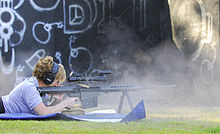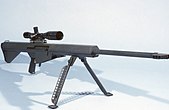The Barrett M82, standardized by the U.S. military as the M107, is a recoil-operated, semi-automatic anti-materiel sniper system developed by the American Barrett Firearms Manufacturing company. Despite its designation as an anti-materiel rifle, it is used by some armed forces as an anti-personnel system. The M107 variant is also called the Light Fifty for its .50 BMG (12.7×99mm NATO) chambering and significantly lighter weight compared to previous applications and the 15% heavier base M82 model.[1][2] The weapon is found in three variants, the original M82A1 (and A3), the bullpup M82A2 and Barrett M107A1 with muzzle brake designed to accept suppressor and made out of titanium instead of steel. The M82A2 is no longer manufactured, though the XM500 can be seen as its successor.
Contents
Overview[edit]
Barrett Firearms Manufacturing was founded by Ronnie Barrett for the sole purpose of building semi-automatic rifles chambered for the powerful 12.7×99mm NATO (.50 BMG) ammunition, originally developed for and used in M2 Browning machine guns. The weapon was first sold to the Swedish Army in 1989. In 1990, the United States armed forces purchased the M82A1 during operations Desert Shield and Desert Storm in Kuwait and Iraq. About 125 rifles were initially bought by the United States Marine Corps, and orders from the Army and Air Force soon followed. The M82A1 is known by the US military as the SASR—"Special Applications Scoped Rifle", and it was and still is used as an anti-materiel rifle and explosive ordnance disposal tool.
In 2006, Barrett completed development of the XM500, which has a bullpup configuration similar to the M82A2.[citation needed] Barrett M82 rifles were bought by various military and police forces from at least 30 countries, such as Belgium, Chile, Denmark, Finland, France, Germany, Greece, Indonesia, Italy, Jamaica, Mexico, the Netherlands,[3] and others.
The Barrett M82A1 rifle was used in 2002 as a platform for the experimental OSW (Objective Sniper Weapon) prototype. This weapon was fitted with a shorter barrel, and fired 25mm high-explosive shells developed for the 25×59 mm OCSW (Objective Crew Served Weapon) automatic grenade launcher. The experimental OSW showed an increased effectiveness against various targets, but the recoil was beyond human limitations. This weapon, also known as the Barrett "Payload Rifle", has now been designated the XM109.
Use by the Provisional IRA[edit]
The Provisional IRA smuggled a number of M82s into Ireland from the United States in the 1980s, apparently made and sold by a gunsmith and former Barret Firearms employee in Texas. One of the M82s was shipped from Chicago to Dublin in pieces, where it was re-assembled.[4] The IRA equipped two sniper teams with the light-fifties,[5] later reinforced with a couple of M90s bought in the United States from an arms dealer in 1995.[6] The IRA snipers killed five soldiers and a constable with .50 rifles from 1992 to 1997.[7] The snipers usually fired on their targets from a distance of less than 300 metres, despite the 1,800 meters effective range of the weapons.[8]
M82 to M107[edit]
The XM107 was originally intended to be a bolt-action sniper rifle, and the rifle Barrett M95 was originally selected by the U.S. Army in a competition between such weapons. However, under the trials, the decision was made that the U.S. Army did not, in fact, require such a weapon.
Then the Army decided on the Barrett M82, a semi-automatic rifle. In summer 2002, the M82 finally emerged from its Army trial phase and was approved for "full materiel release", meaning it was officially adopted as the Long Range Sniper Rifle, Caliber .50, M107. The M107 uses a Leupold 4.5–14×50 Mark 4 scope.
The Barrett M107 is a .50 caliber, shoulder-fired, semi-automatic sniper rifle. Like its predecessors, the rifle is said to have manageable recoil for a weapon of its size owing to the barrel assembly that itself absorbs force, moving inward toward the receiver against large springs with every shot. Additionally, the weapon's weight and large muzzle brake also assist in recoil reduction. Various changes were made to the original M82A1 to create the M107, with new features such as a lengthened accessory rail, rear grip, and monopod socket. Barrett has recently been asked to develop a lightweight version of the M107 under the Anti-Materiel Sniper Rifle Congressional Program, and has already come up with a scheme to build important component parts such as the receiver frame and muzzle brake out of lighter-weight materials.
The Barrett M107, like previous members of the M82 line, is also referred to as the Barrett "Light Fifty". The designation has in many instances supplanted earlier ones, with the M107 being voted one of 2005's top 10 military inventions by the U.S. Army.[9]
Technical description[edit]


The M82 is a short-recoil semi-automatic firearm. When the gun is fired, the barrel initially recoils for a short distance (about 1 in (25 mm)), while being securely locked by the rotating bolt. After the short travel, the lower part of accelerator arm, held by receiver upper part, is already hinged in bolt carrier and the middle portion strikes it back to the barrel by a rod place in bolt carrier, transferring part of the recoil energy of the barrel to the bolt to achieve reliable cycling and unlock it from barrel. The bolt is unlocked by turning in the curved cam track in the bolt carrier. Then, the barrel is stopped by the combined effect of the accelerator, buffer spring and the muzzle brake and the bolt continues back, to extract and eject a spent case.[clarification needed] On its return stroke, the bolt strips the fresh cartridge from the box magazine and feeds it into the chamber and finally locks itself to the barrel. The striker is also cocked on the return stroke of the bolt. The gun is fed from a large, detachable box magazine holding up to 10 rounds, although a rare 12-round magazine was developed for use during Operation Desert Storm in 1991.
The receiver is made from two parts (upper and lower), stamped from sheet steel and connected by cross-pins. The heavy barrel is fluted to improve heat dissipation and save weight, and fitted with a large and effective reactive muzzle brake. On the earlier models, the muzzle brakes had a round cross-section; later M82 rifles are equipped with two-chamber brakes of rectangular cross-section.
M82A1 rifles are fitted with scope mount and folding backup iron sights, should the glass scope break. The U.S. military M82 rifles are often equipped with Leupold Mark 4 telescopic sights. The M82A1M (USMC M82A3) rifles have long Picatinny accessory rails mounted and US Optics telescopic sights. Every M82 rifle is equipped with a folding carrying handle and a folding bipod (both are detachable on the M82A3). The M82A3 is also fitted with a detachable rear monopod under the butt. The buttpad is fitted with a soft recoil pad to further decrease the felt recoil. M82A1 and M82A3 rifles could be mounted on the M3 or M122 infantry tripods (originally intended for machine guns) or on vehicles using the special Barrett soft-mount. The M82A1 can be fitted with a carry sling, but according to those who carried it in the field, the M82 is too uncomfortable to be carried on a sling due to its excessive length and weight. It is usually carried in a special carry soft or hard case.
The M82A2 differed from M82A1 mostly in its configuration; the pistol grip along with trigger was placed ahead of the magazine, and the buttpad placed below the receiver, just after the magazine. An additional forward grip was added below the receiver, and the scope mount was moved forward.
The maximum effective range of the M107 is 2,000 yards (1,830 m). The maximum range of this weapon (specifically the M107 variant) is 4,400 yards (4,000 m), as quoted in the owner's manual. Fifty caliber (and larger) rounds have the potential to travel great distances if fired in an artillery-like fashion (with a high angle, which creates an indirect-fire situation), necessitating the observance of large safety margins when firing on a range.






Replies
M82 — самозарядная винтовка с коротким ходом ствола. При выстреле ствол отодвигается на небольшую дистанцию (примерно 2,5 см), при этом запирается поворотным затвором на три боевых упора. После короткого хода затвор поворачивается и высвобождает ствол, который двигается обратно, переводя часть энергии отдачи ствола затвору, чтобы обеспечить соответствующий поворот. Ствол останавливается, а затвор отодвигается назад, чтобы выбросить гильзу. После выбрасывания гильзы из магазина вверх в патронник движется патрон, который запирается в стволе. Питание осуществляется от большого коробчатого магазина на 10 патронов, хотя во время операции «Буря в пустыне» встречались и 12-патронные магазины. Ствольная коробка состоит из двух частей, изготавливается методом штамповки из тонкой листовой стали, а части соединяются штифтами. Ствол холоднокованный, оснащён дульным тормозом двухкамерной конструкции, поглощающим до 30 % отдачи. Отверстия для охлаждения и продольные рёбра снижают заодно массу и отдачу. На старых моделях дульный тормоз имел крестообразную форму, позднее тормоз получил двухкамерную конструкцию и прямоугольную форму.
Barrett M107A1[править | править код]
В октябре 2010 года Barrett неофициально намекнул на прекращение производства стандартных винтовок M107, а в январе 2011 года объявил о выходе новой винтовки M107A1. В качестве улучшений было представлено очередное снижение массы на 5 фунтов, дульный тормоз цилиндрической формы из титана, титановый ствол с уменьшенной отдачей и возможностью установки глушителя, а также другими функциональными модификациями, повышавшими надёжность и эффективность винтовки[5].
Barrett M107CQ[править | править код]
Дальнейшее коммерческое развитие M107 получила в виде варианта M107CQ, который использовал те же патроны 50-го калибра. Масса была снижена на 5 фунтов, а ствол укорочен на 9 дюймов. Из винтовки, согласно заявлениям производителя, можно было вести огонь из вертолёта, использовать её для прикрытия с моря сухопутных войск, для стрельбы из разведывательных бронемашин, применять в условиях городских боёв не только как стрелковое оружие, но и как оружие для рукопашного боя[4].
Винтовка XM107 изначально была задумана как снайперская винтовка с поворотным затвором, а Армия США изначально выбрала винтовку Barrett M95 по итогам испытаний. Однако вскоре по итогам испытаний выяснилось, что требованиям американской армии подобное оружие не соответствует. Именно тогда Армия США сделала окончательный выбор в пользу Barrett M82. Летом 2002 года по итогам испытаний новую доработанную винтовку M82 приняли на вооружение под названием Long Range Sniper Rifle, Caliber .50, M107 (с англ. — «Дальнобойная снайперская винтовка 50-го калибра модели 107»). Эта винтовка использовала оптический прицел Leupold 4.5—14x50 Mark 4.
The Barrett M82, standardized by the U.S. military as the M107, is a recoil-operated, semi-automatic anti-materiel sniper system developed by the American Barrett Firearms Manufacturing company. Despite its designation as an anti-materiel rifle, it is used by some armed forces as an anti-personnel system. The M107 variant is also called the Light Fifty for its .50 BMG (12.7×99mm NATO) chambering and significantly lighter weight compared to previous applications and the 15% heavier base M82 model.[1][2] The weapon is found in three variants, the original M82A1 (and A3), the bullpup M82A2 and Barrett M107A1 with muzzle brake designed to accept suppressor and made out of titanium instead of steel. The M82A2 is no longer manufactured, though the XM500 can be seen as its successor.